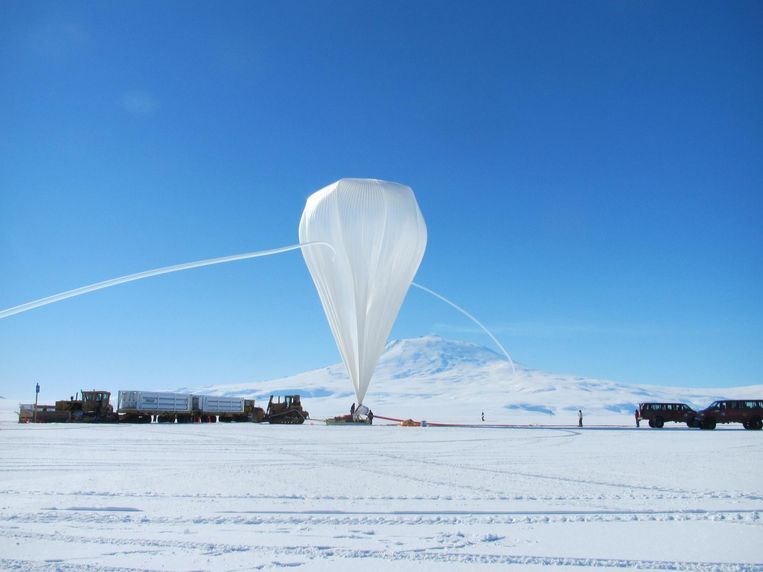Preparations with the telescope balloon.Image NASA
It’s less crazy than it might sound: launching a telescope with a balloon. After all, launching a balloon is cheaper and faster than launching a telescope into space with a rocket. Furthermore, the chance of catastrophic failure is reduced. If something goes wrong with a rocket launch, you will lose billions of euros and countless years of development time. If something goes wrong with the balloon, the telescope can safely return to Earth, dangling from a parachute.
NASA’s hot air balloon telescope Gusto will soon float about 30 to 40 kilometers above the Earth’s surface after launch. Not yet close to the ‘border’ with space, but high enough to be less affected by water vapor in the atmosphere, which emits radiation at exactly the frequencies that Gusto wants to measure.
Over by author
George van Hal is science editor for de Volkskrant. He writes about astronomy, physics and space travel. Van Hal published books about everything: from the universe to the smallest building blocks of reality.
When you think of a telescope hanging under a balloon, don’t think of wobbly strings that you can see under toy balloons. It is relatively quiet at high altitudes and the balloon also moves with the air currents.
Void among the stars
Once at the target altitude, Gusto will peer deep into our home galaxy, the Milky Way, during its mission duration of at least 55 days. Additionally, it will view our smaller neighbor galaxy, the Large Magellanic Cloud. In both systems, the focus is on the so-called interstellar medium, the material that swirls in the large voids between the stars, and the radiation that permeates such areas. In this way, astronomers hope to learn more about how stars are formed and how galaxies evolve.
Although Gusto is a mission of the American space agency NASA, Dutch scientists and engineers are closely involved in both the construction and the scientific analysis of the measurement data. “I have mainly been busy checking everything lately – the detectors, the electronics, that kind of thing,” says José Silva of the Dutch space research institute Sron on the telephone from Antarctica, where Gusto will not arrive until Christmas Day at the earliest. will be released. ‘It’s actually a bit like fine-tuning a car.’
Illustration of the telescope high in the atmosphere.Image NASA
There are several reasons why Gusto is launched from Antarctica. For example, there is even less water vapor above the continent than elsewhere, the summer in Antarctica is favorable for the power supply – Gusto is equipped with solar panels – and the air flow from the polar vortex ensures that the telescope can stay above the continent for longer. Plus: Gusto does not cross any politically sensitive national borders, and in the event of an emergency landing, the telescope does not accidentally end up on someone’s house.
However, despite all these advantages, the harsh environment also presents many practical challenges. “For example, the balloon facility is 15 kilometers from the camp here,” he says. ‘By the way, that building is 15 meters high. Did you know that this makes it the tallest building in all of Antarctica?’, he says laughing. “That’s a fact that I always like to share with people.”
Heavy snow storm
The journey to that modest record-height building from its home in Antarctica takes about 45 minutes – not an unusual journey time for the average commuter. ‘Only: there is really nothing else there. When I had just arrived in Antarctica, I had to return to our accommodation after half an hour because a heavy snow storm was about to pass through and it would not be safe in the balloon facility. In the end it turned out to be a false alarm, but something like that would cost you half a day.’
Silva has been working on Gusto detectors for a few years, ‘the heart of this telescope’, as he describes it. ‘That is why most attention is paid to it. Do all pixels work? Are they sensitive enough? Those are my biggest concerns.”
Because although a balloon launch is relatively cheap, it is still not possible to simply take the telescope down for a repair, or to fly an engineer to an altitude of 40 kilometers to solve a problem on site.
A mitigating circumstance is that the telescope will soon be ‘on’ when it takes off. This is often impossible in the interior of a rocket, so that after launch there is tension to ensure that all instruments are turned on properly. The tension is already gone here.
269 degrees below zero
Still, the launch itself is not entirely without technical challenges, Silva says. “For example, our detector must be cooled to 269 degrees Celsius below zero,” he says. This detector uses superconductivity, which only occurs at very low temperatures. ‘Even 250 degrees below zero would therefore be too hot.’
At the time of launch, all this technology has already been extensively tested. ‘We first do a test to see if everything works, going through every part of the instrument.’ Silva and colleagues hang the telescope from a crane and switch it on. ‘That test was actually the most exciting moment – more exciting than the balloon launch itself.’
Also read
2023-12-25 07:37:05
#Balloon #telescope #Gusto #largest #cosmic #Christmas #ball #ready #space #journey
